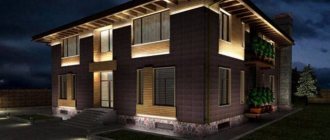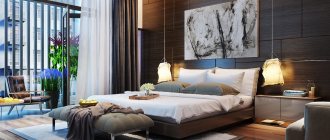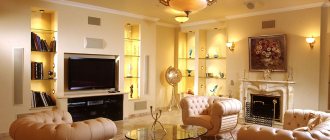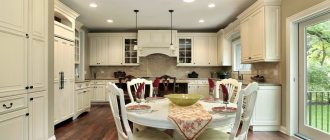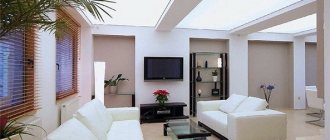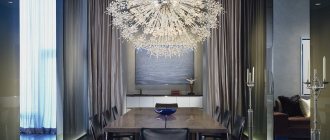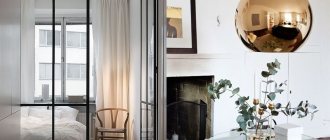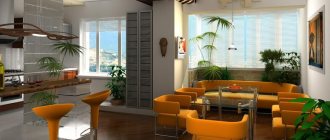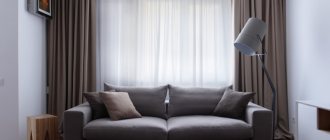The organization of lighting directly affects the perception of the room’s design and how a person will feel in it. Correctly selected light can create and emphasize accents in the interior, visually increase or decrease the space, and help in zoning the room. It is important to take into account the features of selecting lighting for a specific type of apartment.
To make the space seem larger and brighter, and to fill your home with comfort and warmth, you need to carefully consider the lighting in the apartment.
Lighting in a modern studio apartment is used to divide into zones. Designers recommend emphasizing the kitchen area with more powerful lamps whose lighting temperature is close to daylight. And for a resting place, dim light is good. Studio lighting standards depend on its area - for every 5 square meters there should be at least 60-75 kW of power.
Light sources should give a feeling of confidence that everything is in its place.
Light in a standard one-room apartment should come from eight lamps, including both basic and local lighting. According to the rules, the total minimum power of lamps should be close to 300 kW.
When planning a lighting system for a small apartment, you should not overload it with an excessive number of lamps.
In a two-room apartment, nine lighting fixtures with a total power of 560 kW will provide a sufficient level of illumination.
Lighting in an apartment can be natural or artificial. To achieve the best result, you need to properly combine both of these light sources.
Eleven light sources are needed for the three-ruble note. Without taking into account decorative lighting, their total power should be close to 660 kW.
If the apartment windows face the shady side and the sun is a rare guest in the room, you should not cover the windows with thick curtains.
Important! In modern conditions, when creating a lighting project, it would be more correct to focus not on the power level, but on the light transmission of the lamp and its type. The total light transmission index depends on the type of lamps used. This is the ratio of the emitted light flux to the lamp power. For example, an incandescent lamp has a minimum index of 15 lm/W. And for halogen ones it is four times more - 60-90 lm/W
Lighting is divided into natural and artificial:
1. The first is street (daylight) light. It is impossible to stay indoors for a long time without it. Sunlight solves many problems.
- light is a natural antibiotic that disinfects the room. According to sanitary rules and building regulations, insolation (lighting by direct sunlight) of a living space should be at least 2 hours a day. All microdistricts and residential buildings in Russia are designed with this in mind.
- Natural lighting has a good effect on a person’s health and psychological state, increases immunity and reduces the risk of depression.
2. Second - all light sources inside the house. It is they and their proper placement that will help make the interior not only beautiful, but also comfortable for life (by this I mean the level of a person’s physical and psychological state). Let's talk about this.
Lighting control methods
In addition to the usual switch, you can install transitional switches to turn the light on and off from different points - this option is suitable for long and voluminous walk-through rooms.
It is very convenient to install a switch with a motion sensor in the hallway. In this case, the light will turn on itself when a person appears in the hallway’s visibility zone, and will turn off when he moves away. This option will also help save energy if not all residents like to turn off the lights behind them.
You can install a dimmer to adjust the brightness of the lighting.
Dimmers are:
- mechanical - with a rotary knob that adjusts the brightness in the same way as adjusting the volume;
- electronic, push-button - it can be used both as a regulator and as a switch, pressing buttons and selecting different operating modes;
- touch - with a touch panel to implement functions;
- remote - controlled via a remote control.
Some of them work in such a way that when the brightness of the lamps is reduced, the energy consumption of the light bulbs is reduced; for others, this function is not available. You can read about this in the technical description of the device.
Where to begin? Features of modern lighting in the interior
Start with yourself and determining your own needs!
Think about what you like to do, find a suitable area for it. Always try to answer the question “Why?”, then errors will be minimal.
For example: “There will be a sconce here because on this wall I want to hang my favorite reproduction and highlight it with light. And this simple sconce design will be white, like the wall, because the main thing is the picture and the emphasis should be on it.”
Correct lighting
Two factors influence lighting efficiency:
- Lamp power
- Number of light sources
By varying the number of lamps, you can successfully reflect the light scenario of the room.
To arrange functional areas, for example, for relaxation, eating, work, games, etc., lighting fixtures of different brightness are combined. The skillful use of light and shadow emphasizes all the advantages and hides the flaws of the room.
Lighting scenarios in the apartment
You can create several scenarios in one space:
- bright main lighting (chandeliers and any ceiling lighting).
- muted evening, when bright light is not needed (sconces, floor lamps, decorative lamps, hidden lighting).
- accent lighting for an area or object. When you need to highlight something (ceiling and wall lamps with directional light).
- festive (decorative lamps, garlands)
When we talk about lighting options, we assume that different lamps will be turned on from different switches. You can also use pass-through switches for convenience. You can turn on the lighting from two switches located at different ends of the room. Such switches are convenient to use in long rooms, corridors, and bedrooms.
Using dimmers will also help in creating different lighting scenarios. The invention, of course, is not new, but very useful. Using a dimmer switch, you can adjust the illumination from each lamp. It is important to remember here that not all lamps are dimmable. Most LED lamps are non-dimmable.
Thinking through scenarios and making electrical wiring is one of the first stages in repairs.
Some features of apartment lighting
When designing lighting in an apartment, you must remember that it is divided into:
- general;
- working;
- decorative
General lighting devices include elements placed on the ceiling or under it to ensure uniform distribution of light fluxes in the room.
As a rule, these are chandeliers with different numbers of bulbs. The main condition for such lighting is to ensure the absence of shadow areas.
Lamps that provide shadow effects are classified as decorative.
Work lighting is directional lighting that concentrates light fluxes in a specific place to create the most favorable conditions for vision when performing various types of work. It is organized in premises according to their functions.
Apartment lighting options may vary. They depend on many factors: financial, personal, business, etc.In recent years, designers have been advising the use of combined options that combine the use of several types of lighting devices, which creates significant ease of use.
Advice. Do not forget about organizing the control of room lighting devices. Fulfillment of this condition will create additional convenience during their operation.
One option is to use a pass-through switch. It allows you to turn on (turn off) the room lighting from various points.
- LED lamps - which are better? Review of the most popular and reliable models, with photos and videos!
How to choose a color temperature - see here! Table, instructions, overview of bright and optimal color temperature for the room
Connecting a lamp with your own hands - step-by-step instructions with photos and videos. Installation rules + connection diagram
What to choose for the main lighting in the living room?
Chandelier
A chandelier is one of the types of pendant lamps designed to create shadow-free lighting.
The chandelier is the central element. It can become an accent in the interior, highlight a certain area, and act as the main source of lighting. For example, it will fit perfectly above the coffee table in the sofa area and become the main compositional element of the relaxation area. There is a truth and a minus: the possibility of rearranging furniture is limited by the fact that the chandelier organizes the space around itself.
In what interior is it appropriate to use a chandelier?
It is customary to emphasize the space with a chandelier, so it should be enough. Classic chandeliers are more vertically elongated, so they require high ceilings. Chandeliers in modern styles can be both horizontal and vertical.
If we talk about styles, designers are experimenting more and more and, along with understandable things, combining seemingly incompatible things! It is quite possible to find a classic chandelier in a concrete apartment, or, conversely, a modern geometric one - in walls with wide cornices and openwork moldings.
Using a classic chandelier in a traditional interior, you almost don’t have to worry about the result - it will probably fit well there! But if you want to make an unusual accent element, be careful! The rest of the interior in this case should become the background, here and there in small details only emphasizing the style of the chandelier.
The installation height depends largely on the situation. Usually at least 2.2 m from the floor, so as not to touch your head or hands. However, if the chandelier hangs above the coffee table in the living room, it would be appropriate to make it lower.
One chandelier in the center of the room will not solve the lighting issue. This is the main element that gives a lot of light, but with it alone the corners will remain in the shadows. Therefore, additional light sources are necessary.
Spot lighting (spots)
Spotlights are small lamps with directional light, having a certain angle of light propagation and radius of illumination.
Types of ceiling spotlights:
- built-in spots
- surface mounted lamps
- track systems
The peculiarity of the lamps is that they can be used both as main lighting and as accent lighting. The main thing is to choose the right lamp. Lamps come with different beam angles. For example, a conventional incandescent lamp has a scattering angle of 360 degrees, i.e. it shines in all directions and gives a general flood light. Halogen and LED spotlights with GU10 and GU5.3 sockets have a narrower angle. Most often it varies from 20 to 150 degrees. The range from 20 to 40 is suitable for local illumination of a painting or decorative elements. For basic lighting you need an angle of more than 60 degrees.
Spot and track lamps are appropriate in almost any interior, be it an interpretation of the classics, loft or minimalism. You can make them completely invisible or, conversely, accentuated.
If you use lamps as the main lighting, it is important to correctly calculate exactly how many lamps are needed and at what distance from each other they should be located. As a rule, the distance between spotlights is no more than 1.5 m. Of course, there are calculation formulas, but it is best to contact a lighting store, where the manager will help you determine the required power and number of lamps for your room.
Result:
Use a chandelier in a tall, large room in combination with additional lighting elements.
Spotlights are suitable for rooms with low ceilings, rooms with frequent rearrangements, and for accent lighting.
Rules for organizing lighting
There are several rules for installation and distribution of light fluxes in a room (apartment). Their accounting and use will help make lighting in the apartment convenient and practical.
Local lamps are the main assistants in organizing lighting. They will help to correctly distribute the room into zones and emphasize the functionality of its areas.
Multi-level lighting of an apartment (room) is an absolute and mandatory element of its arrangement. It must be remembered that the lower the light element is placed, the more intimate the atmosphere of the room.To create comfort and coziness in the room, it is necessary to equip lower light zones. As an example, use candles or fireplace fire.
Correct use of incandescent lamp colors. Basic shades of white:
- warm light (less than three thousand three hundred Kelvin);
- natural white (from 3300 to five thousand kelvin);
- cool (more than five thousand kelvin).
It is advisable to use warm light in living rooms, bedrooms, and children's rooms. The second is in hallways and work rooms. The third is most rationally used as lighting for work surfaces in the kitchen. It must be remembered that the higher the Kelvin temperature, the cooler the luminous flux.
Ensuring the conservation of electrical energy. Existing standards establish requirements for providing illumination of 1 m2 of room with a ten-watt light element.
Modern light bulb manufacturers evaluate their efficiency in the form of luminous efficiency, which is defined as the ratio of lumens to watts. The most economical in this spectrum are energy-saving lamps.
Proper accentuation of light flows in the room. Ceiling lights create the illusion of height, chandeliers with lampshades create the impression of a low room.
In rooms with a small area it is advisable to use bright lamps. Spotlights, decorative lamps are more appropriate to use in large areas.
Advice. The lamps used in the lamps are of no small importance for the lighting equipment of the apartment. Their choice must be approached responsibly, carefully choosing according to power, illumination and other characteristics.
Each home owner determines personally which lighting for the apartment will be best for his family. The choice may be based on the characteristics of the premises, hobbies of household members, age of family members, economic and other reasons.
But in any case, the rules for organizing lighting in the apartment and technical requirements always remain the same. Compliance with these conditions will help each person create apartment lighting that is convenient for him and his family members.
Wall lamps (sconces) – which ones and why?
Wall lamps are sources of additional lighting mounted in a wall or on a wall. There are two types - built-in or overhead (sconces).
Overhead sconces come in different designs:
- Carobaceae. The most familiar and widespread type of sconce.
- Wall (surface). Appropriate in cases where the room is narrow so as not to interfere with the passage. Most often used in corridors and staircases.
- Lighting for pictures.
- Stationary. Sconces that do not have additional scenarios illuminate only in one position.
- Adjustable. The design of such sconces has movable elements, by controlling which you can change the lighting.
- With reflected light. Such sconces give a soft, light light. Most often, wall sconces are found with reflected light.
- With directional light.
The type of sconce largely depends on the style of the interior and its purpose.
Switch the main light to the sconce and achieve a subdued, cozy atmosphere. They will help organize a work area, a place for reading, and highlight an interesting wall texture.
If you want to use a sconce in your work area instead of a table lamp, try an option that can be adjusted from the wall up to 60 cm so that you can control the light as needed.
Remember, the lamp should not interfere with the passage. If the room is narrow, use surface sconces that do not protrude too much. Or ditch them altogether and use accent ceiling lighting.
Any lamp needs space, so choose a place for the sconce so that it is not “crowded” on the wall.
Ceiling lighting
Modern lighting design ideas give a special role to ceiling lighting. In most cases, the choice of lighting fixtures evokes positive emotions, but placing purchased light bulbs and hiding them (when creating hidden lighting with your own hands) is not always easy. Before starting the installation of spots, it is recommended to identify three main light sources in the interior (local, local and decorative).
For low ceilings
If the ceiling in the apartment is quite low, then there can be no talk of any tension or even suspended structures. Hanging chandeliers and massive lamps are not suitable. Recessed spotlights cannot be built in here, but overhead versions can be installed. Flat-shaped ceiling chandeliers, track lighting systems and LED panels will fit harmoniously.
Hidden ceiling lighting
You can build two types of hidden lighting with your own hands: using a niche made of plasterboard and with a cornice made of polystyrene foam. And the combination of a plasterboard box and a stretch ceiling with hidden lighting perfectly hides minor errors that occur when constructing a ceiling yourself.
Kitchen and dining group
The kitchen area should have general lighting and work surface lighting. This is a set necessary for convenience and cooking.
In addition to uniform lighting with lamps, it would be nice to place a lamp above the dining group. This could be a pendant lamp or sconce.
The lamp should be installed in the kitchen at a height of 1.3-1.4 m from the floor (50-70 cm from the countertop).
If we talk about lamps above the bar counter, then the height here should be made a little higher - 1.6-1.8 m from the floor.
If the table is against the wall, you can use sconces. An interesting solution is a cantilever wall lamp with a reach of up to 1 meter in length. The installation height of such a lamp is also 50-70 cm from the tabletop.
If your room is small in size, do not overload it; use small lamps or lamps in light colors or with glass shades. Openwork lamps made of metal or wood can look impressive.
Many manufacturers produce series of lamps, in the same material, but in different sizes and shapes, and invite us to experiment and use our imagination. Combine in different combinations and hang at different heights!
Installation of LED strip around the perimeter
Self-adhesive tape is best suited for this case; it can be attached to or above the baseboards. When selecting materials, it is necessary to take into account that manufacturers make 5 m tapes with different diodes and power consumption. It is not recommended to connect more than two tapes to one power supply. Therefore, it is necessary to carefully calculate the length of the perimeter, the number of tapes and power supplies of appropriate power. For a perimeter of 20 m you will need 4 tapes and 2 power supplies; the number, brand of diodes and power consumed by the tape are indicated on the label. LED strips are classified according to many criteria:
- LED brand;
- color - there are single-color with one crystal or colored with 4 crystals: white, blue, red, green (RGB). Tapes with multi-color diodes can be connected to a program control unit, setting time parameters for changing brightness and color gamma;
- supply voltage can be 12, 24 or 36 V;
- by the number and size of diodes;
- and other signs.
At home, floor-mounted night lighting is often powered by a 12 V unit. SMD 5050 strips with 5 mm diodes, 30 pcs/m, create a moderate level of illumination.
Appearance of various models of LED strip, indicating cut locations and terminals with polarity for connection
Calculation of the required power supply power
A 5 m long SMD 5050 tape containing 30 diodes/1 m consumes 7.2 W/1 m;
7.2 W x 5 m = 36 W. Two tapes consume 72 W, which means you will need a slightly larger power supply, safety factor 1.25 x 72 W = 90 W. For a 20-meter perimeter you need 2 such blocks and four tapes.
Installation sequence
- The protective film is removed from the tape, the diodes are glued along the baseboard or above it.
Mounting the plinth with strip lighting
- It is recommended to use plastic skirting boards with cable channels where the wires are hidden.
- The power and control unit can be placed under the floor covering.
- The switch and program control panel are installed on the wall, the remote control is not tied to a specific location.
Simple, reliable and economical. Don’t forget, the floor lighting strip must have a moisture protection rating of IP65 or IP68; insulate the wire connections with sealant or heat-shrinkable tubing. Then the assembled system will work for a long time, creating cozy night lighting in the apartment and ensuring safety when moving in the dark.
What can you experiment with?
With wire!
Pendant lamps with textile braided wires look impressive. This can be a twisted wire or a simple round braided wire. The number of color options is huge!
Exposed wiring can be an interesting design element. Attach it to the surface of the wall or ceiling with clips for open wiring; if the cable is twisted, use insulators.
It is important to know!
If you use a ceiling lamp or chandelier in the center of the kitchen as the main lighting, do not hang pendant lamps above the dining room! They will "argue" with each other. The best solution would be sconces.
If the main lighting is spotlights, pendant lights above the dining room would be a great option!
Sources of light
Before installing lighting, you need to figure out which lighting fixtures are best suited for a particular room.
Spotlights
Obviously, a chandelier is not always a suitable solution for a small room. In a compact space, the lamps should be compact. Therefore, one of the popular lighting options are spotlights.
Such light sources may not be very powerful, so it is desirable that they provide diffused light and there are several of them. You can place it either in the center of the hallway or closer to the walls, or you can arrange it in the shape of a zigzag or arc.
Neon lamps and flexible neon
Neon lighting was especially popular in the 1980s, and now it has been given a second life. Now a neon lamp is an interesting design move that can be used as additional lighting.
The lamp itself is a tube filled with gas that produces colored light. The tube can be hidden and get the effect of hidden lighting. In cases where it is necessary to highlight a curved surface, flexible neon can be used.
LED strips
LED strips are economical, safe lamps that can be placed along any trajectory. They come in warm and cool shades, as well as colored ones. Most often, tapes are used as curtain lighting or illumination of a multi-level ceiling.
Since the LED strip consists of small, bright bulbs, it should not be placed in front of a reflective surface, otherwise you will have to use a diffuser.
If this is not done, the reflection from the hidden light bulbs will be visible, and this is unsightly, because the effect of such illumination is to hide the light source.
LED duralight
LED duralight is a kind of light cord. This is a hollow polyvinyl chloride tube into which LED bulbs are soldered. It can be cut and bent. The lighting can be any color, and the tube itself can be transparent or frosted.
Light floor
A light floor is a very unique way to decorate a room in a hallway. These are square LED modules that are mounted on the floor. They can be arranged in the form of a pattern or designed as a path - it will look original, although this type of lighting is rarely used in the interior of an apartment.
Corridor lighting
Let's consider several options. Let's say we have a wide, spacious hall with a width of at least 1.5 meters with a console table for keys or a banquette. For such a room, central lighting with a chandelier or overhead lamp is suitable. You can make sconces on the walls. Place them, for example, above a table or near a mirror. The installation height of sconces can vary from 1.6 to 1.8 m above floor level.
If your hallway is narrow and long, the best option would be to use recessed or surface-mounted accent lights.
Recessed lamps would be appropriate in a minimalist interior. These can be either spotlights or linear ones.
Advice! If you have a long corridor, you can visually make it smaller by making the far wall an accent wall and highlighting it. All bright or illuminated surfaces appear visually closer.
Lighting design
Before installing lighting elements, it is important to carefully consider the organization of light flows in the apartment during the working day, holidays, and weekends. To do this, it is necessary to take into account the lighting features of each room of the apartment.
The given mathematical formula will help the interested person answer the question: How to calculate lighting for a specific room?
n = SEmk/F, where n is the number of lighting points (pieces); S - room area (square meter); Em is the required room illumination (lux per m2); k - reflection coefficient (1.5-2) (takes into account the color of the walls, ceiling, floor); F – luminous flux from one lighting point (lumen).
Advice. For each specific room of the apartment, it is necessary to place accents depending on its functional purpose.
Bedroom lighting
The bedroom can also have main lighting in the form of a chandelier or spotlights. Although it is often not done in order to initially create a cozy atmosphere for relaxation and sleep. The issue of lighting in this case is solved with decorative lamps. This could be sconces, spot lighting of individual interior elements, or hidden LED lighting. And, of course, night lights by the bed so that, for example, you can read a book.
A convenient height for installing sconces for reading can be about 100-120 cm from the floor.
Bedside lamps can be pendant, wall, or table. By the way, they can be placed asymmetrically - on one side of the bed there is a lamp, on the other there is a table lamp.
If we talk about pendant lamps, you can combine 2-3 lamps together. The recommended installation height for the lampshade is 90 cm from the floor. In this case, it’s a good idea to think of a small hook for fixing them so that they don’t sway from side to side when you accidentally touch them or open a window and the wind blows.
The main thing for bedside lamps is that you can turn them on without getting out of bed. Choose lamps with a switch on the body. Or make a pass-through switch - one at the entrance to the bedroom, the second above the head of the bed.
LED lighting in the interior - photo
NeoclassicalLED lighting in the interior is a very convenient and effective tool for creating an exclusive atmosphere in any room.
Light in the nursery
A child’s room is a whole world with many tasks and functions - it is a bedroom, a playroom, and a workplace. There should be general lighting in the form of a chandelier or spotlights, a sconce by the bed (or pendant lamp), a table lamp, and possibly some other additional decorative lighting.
It is advisable to choose a sconce by the bed in the nursery with a power button on the body and a rotating one so that you can adjust the direction of the light. The installation height of the sconce is at least 50 cm above the bed.
Basic moments
The attractiveness of LED lamps is obvious - the lighting creates a pleasant atmosphere; you can use single-color, colored LEDs, or combine different light sources. The use of LEDs in an apartment allows you to realize design ideas, give rooms an original look, and visually emphasize the advantages of the style.
Lighting using LEDs allows you to decorate walls, ceilings, floors, and highlight any functional area of the room. The products are easy to install, easily attached to the base surface, and you can install them yourself.
An important feature of LEDs is that the devices do not heat the surfaces they come into contact with or are in close proximity to, which eliminates the risk of fire.
Advantages and disadvantages of ice lamps
LED lighting devices appeared on the market relatively recently and quickly gained popularity among consumers. According to reviews, they have important advantages:
- Low energy consumption - a diode device at full power uses 70% less electricity than conventional light bulbs.
- Long service life - with proper calculation and development of the power supply circuit, the lighting operates for about one hundred thousand hours.
- High degree of resistance to damage - the devices are made of durable materials and do not have incandescent elements.
- No flickering effect – when using LED lamps, the voltage on the organs of vision is reduced.
- Minimal heating and heat release - thanks to low heat transfer, all energy is directed to lighting.
- Ease of installation - consumers can very easily install LED lamps with their own hands using glue and self-tapping screws.
Important! LEDs are compact in size, they are convenient to install in corners, niches, narrow openings, where the installation of chandeliers, shades and other products is excluded.
A significant disadvantage of LED light sources is their high price. Expensive, high-quality models cost from 2,000 rubles, budget options will cost from 90 rubles, but the latter, according to reviews, do not work for long. If one device fails, the LED network ceases to function. Since the LED is a semiconductor device, the brightness, power, and light intensity can be affected by the resistance of the conductor.
Types of LED lighting for apartments
Lighting an apartment with LED sources depends on several parameters: the dimensions of the room, interior features, visual zoning, the purpose of using artificial lighting. Based on these criteria, several types of lighting for ceilings, walls, furniture and interiors are distinguished.
Let's highlight the main types:
- Diffused artificial lighting. Acts as the main source of light radiation. The devices evenly fill the apartment with light, covering the entire area of the room. The main requirement for light is neutrality, the absence of unlit “spots” in the room, and calm radiation.
- LED work lighting. Used when zoning the interior space of a room. LED lamps are placed in functional areas where brighter, precisely directed light is required. This could be a work area near the desk, illumination of the area for cooking and eating, or the area around the mirror.
- Accent lighting when developing apartment design. Emphasis is drawing attention to a certain object, fragment, or area of the room. Light sources are positioned so as to visually illuminate paintings, figurines, bookshelves and other interior elements.
- Decorative lighting with LEDs. It does not perform a practical function, it is used to emphasize the aesthetic appeal of the apartment. Properly placed lighting and spotlights help to visually expand the boundaries of the room, complement and “revive” the atmosphere.
Types of lamps
Manufacturers of LED products produce lighting devices with different technical and operational characteristics. When choosing, you need to focus not only on the size of the lamps, but also on their type of glow and power.
There is no strict classification of LED lamps, but conditionally all devices can be divided into several broad groups:
- Based on the source used in the luminaire, a distinction is made between SMD LEDs with a long service life, COB - models of increased reliability with uniform light distribution, high-power and heavy-duty lighting products.
Related article: Apartment lighting: organization, placement options and new ideas | +90 photos SMD LED
- Based on their application, LEDs for street and indoor lighting, industrial models, spotlights, and lamps for illuminating flowers are distinguished. In the apartment you can use any devices intended for indoor use.
LED lamp for illuminating flowers
- Based on the type of base, all LED lamps are divided into screw (E) and pin (G). Options for installation in an apartment: E27 - classic base with thread, E14 - base with reduced diameter, G5.3 - pin for lighting, G4, G9, G10 - backlight.
Different LED lamp bases
- LEDs differ in the shape of the lamp (round, candle, pear-shaped, oval), the presence/absence of a cooling radiator, brightness, color temperature (warm white, yellowish, neutral, cool white light).
Different types of lamps by shape
Important! When choosing an LED device, you need to pay attention to the product manufacturer. Lamps must be made from high-quality components.
Powerful LED lamp option
Life time
There is a concept of average service life for LED devices - 50,000 hours of continuous operation. Modern lighting technology has a complex design and many functional components.
Reliable manufacturers of diode lighting sources indicate in their characteristics that the service life corresponds to the generally accepted value L70 or LM70:
- a year of LED operation will be 9000 hours;
- Manufacturers set a full service life;
- the operation of the device is affected by fluctuations in the network;
- reduces operating time; low light output;
- The design of the LED light bulb plays a role.
Manufacturers of LED products indicate a warranty period of up to one or two years - lamps with a short and medium service life, from three to five years - high-quality LEDs, designed for up to 100,000 hours of operation.
Shower and toilet
In addition to general lighting, it is also good to have mirror lighting in the toilet. This could be a sconce or lighting mounted in a mirror. Its main purpose is to shine light on the face without creating cast shadows. Therefore, it is good if the sconce has a general flood light or with the ability to rotate the lampshade.
Interesting solutions can be obtained with LED backlights. It is only important to remember that it makes sense to highlight something beautiful. This could be a wall made of an unusual material (for example, stone, wood or relief) or a separate interesting element on the wall.
When choosing lamps for wet rooms, you must also look at the level of protection against moisture. It is designated IP44, where the first is protection against penetration of solid objects and dust on a scale of 0-6, the second is the degree of protection from moisture on a scale from 0 to 8. More about this in our other post about the protection class of devices - here . If the lamp is marked IP44, it is suitable for wet rooms.
Panels and stained glass on the wall with lighting
A very popular trend in interior design today is wall lighting in the form of luminous panels and stained glass. It also has a number of its own features:
- Installation of such decorative lighting is best done in spacious rooms with no excess objects - for example, in a living room, office or bedroom.
- Various materials can be used as a base - onyx, glass, stones.
To illuminate walls of this type, ready-to-install light sources are best suited. Decorative lighting for panels and stained glass is available in several variations:
- Under a transparent base. LED strips, gas-discharge tubes and light bulbs are used. The latter are relevant when you need to highlight specific areas of the structure.
- Along the contour it is open from the outside or hidden from the sides, when only the light is visible, and not the devices themselves. Ice strips are used (the most convenient option due to the high plasticity of the lamp material).
- Outside. If light sources are not part of the decoration, then they are mounted separately from the composition - on walls, ceilings and other interior items using brackets. Directional lamps and lanterns are best suited here.
As an example, let's look at how to install LED strip lighting discreetly along the contour of a panel on the wall:
- To ensure the functionality of the backlight, you will need an LED strip, a power supply for it, additional equipment (control unit, dimmer, if you plan to programmatically change its lighting characteristics during operation).
- The structure of the panel should involve the hidden placement of an ice strip for illumination along the contour. These can be either individual elements or around its perimeter.
- The LED strip must be secured to double-sided self-adhesive tape, or to plastic or aluminum strips, which themselves are attached with self-tapping screws or glued.
- Then you need to connect it to the wiring, power supply and other related equipment.
- Turn on and check the functionality of the wall lighting.
- Disconnect electrical appliances, install panels, and make sure the lighting is working.
LED lightening
Apartment renovation done in a modern style involves the installation of high-quality, durable lighting. All rooms must be provided with basic, additional, and optional decorative light sources. LED lamps can be used in different interior styles. For classic designs, warm, neutral light is appropriate, and in high-tech, high-tech, modern, fusion, and loft designs, diode sources of a cold glow look relevant.
Article on the topic: Features of lighting in the kitchen: what is it and how to organize it? (current ideas)
Ceiling
The traditional way to install main lighting is to install the devices on the ceiling. Due to this, optimal distribution of light throughout the room is achieved, and niches, corners, and darkened areas are illuminated with additional sources.
Location of LEDs on ceiling structures:
- Installation in a plasterboard niche. The shape of the niche can be rectangular, square, curvilinear, oval. Drywall is mounted on the frame; wires can be hidden behind the sides of the structure. Chandeliers, spotlights, ice panels and LED strips are suitable for decoration.
- Illumination around the perimeter or contour. Wiring elements can be hidden behind the ceiling profile. LED strip and spotlights are used as lighting sources. The lighting should be directed towards the ceiling.
- Light patterns on the ceiling. The lighting elements (LED strip) are mounted to the base base, the spotlights are installed pointwise, and the tension structure is mounted. When the lights are off, the patterns are invisible, but when the LEDs are turned on, the room is transformed.
Professional designers often use LED lighting in interior projects to achieve the effect of a “floating” ceiling. Light sources are installed between the tension and base structures.
Stan
Decorative lighting of the walls gives the apartment an attractive look. Various designs and geometric patterns form a bizarre play of light and create soft reflections. Ice lighting of the walls expands the boundaries of the room and emphasizes the architectural elements of the interior. It is important that the intensity, brightness and color of the lighting can be adjusted. The proximity of light sources does not spoil the surface of the wallpaper and does not heat up the panels.
LED strip and linear ice lamps are energy-saving materials; using them to decorate walls is profitable and practical. The main areas of illumination are corners, niches, the perimeter of the upper part of the wall, and interior elements. Linear shapes and soft contours look impressive.
Paula
To make the room more spacious and weightless, use LEDs to illuminate the floor. Light source options: tape, flexible neon, tubes with duralight LEDs. Ice panels are used less often (spotwise, in separate islands in living rooms and kitchens). You can choose a standard solution or colored floor lighting around the perimeter of the room.
For small corridors, a flexible neon thread is suitable, laid along the contour of the room at the junction of the floor and the walls of the hallway.
